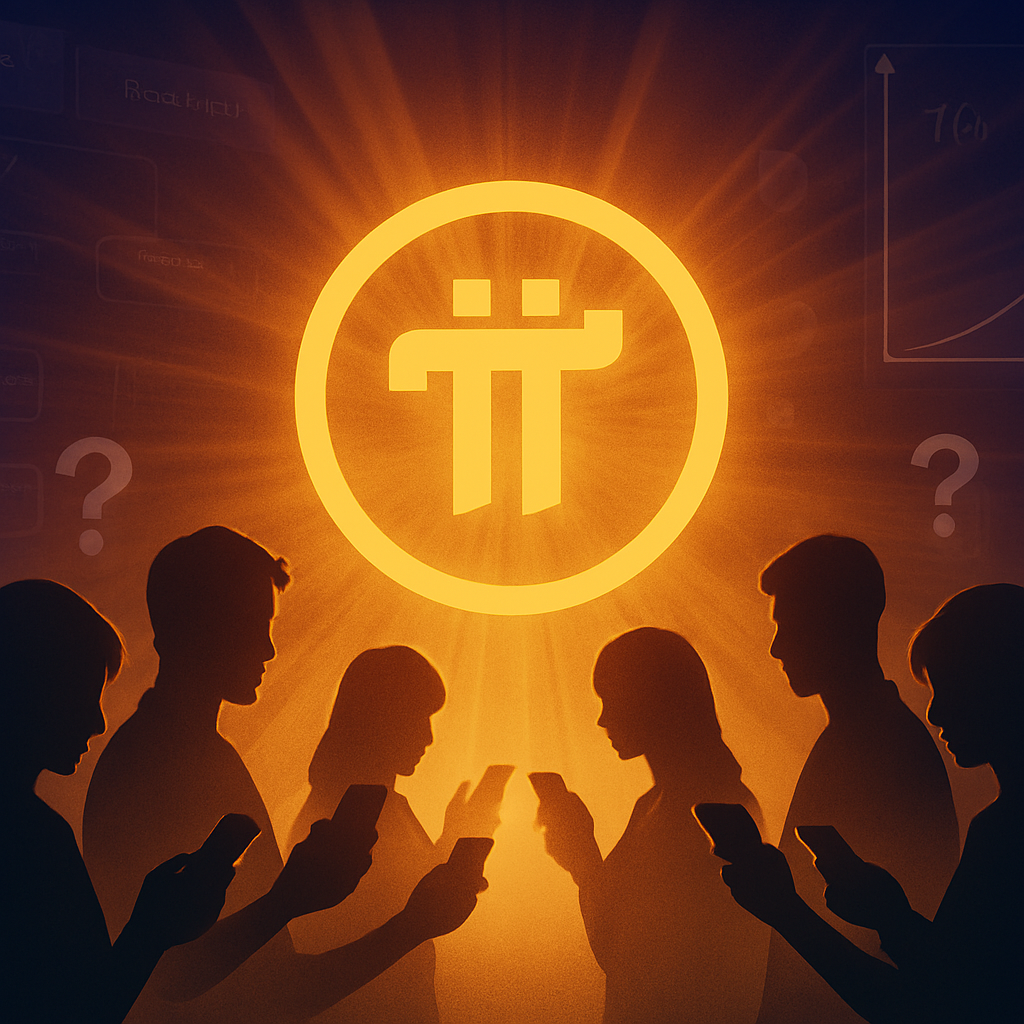
As crypto investors, we're all familiar with Pi Network, a project that continues to draw intense criticism, suffer from prolonged launch delays, and face structural doubts, yet somehow maintains a near cult-like following. This recent report delves into the mystery of what keeps millions of users faithfully tapping a button on their mobile apps every single day.
Launched in 2019 by Stanford-educated founders, Pi Network aimed to democratize crypto mining by using a simple smartphone application instead of energy-intensive hardware. It relies on the Stellar Consensus Protocol (SCP) and social "Security Circles" rather than the Proof-of-Work (PoW) model. Despite finally opening its mainnet for token transfers in February 2025, years behind schedule, the rollout has been frustratingly slow due to migration delays and huge backlogs in the KYC (Know Your Customer) process. This disappointment led to a sharp price decline, dropping from early 2025 highs near $3 to approximately $0.34 by September 2025.
So, why does the hype persist? The core reason is the incredibly low barrier to entry. Mining Pi requires only attention, not capital, making it financially risk-free and accessible to anyone with a smartphone. The system is heavily gamified with layered incentives like referral boosts and security circles, which turn a casual daily tap into a feeling of incremental progress. Furthermore, the strong community identity (users call themselves "Pioneers") and constant ecosystem signals, such as hackathons and developer grants, help sustain emotional investment, prioritizing hope and long-term vision over immediate utility.
However, serious red flags remain. Critics point to the severe centralization of control, with the core team operating all validator nodes, undermining the fundamental decentralization ethos of crypto. Other concerns include opaque tokenomics, referral dynamics that parallel multi-level marketing (MLM), and major privacy risks due to the centralized storage of sensitive KYC data. Analysts agree that the project’s true test lies ahead: demonstrating real-world utility, achieving genuine decentralization through independent validators, and securing listings on major exchanges to establish credible liquidity. For now, faith remains Pi's primary product. (English Word Count: ~250 words)
Concluding Summary (Additional Insight)
The Pi Network phenomenon clearly reflects the power of hope and social incentive within the crypto space. As investors, we must differentiate between a token's sentiment value and its fundamental value. Any project that fails to demonstrate true decentralization and lacks liquidity from major exchanges remains highly risky. Nevertheless, this simple, mobile-first model has proven its massive potential to onboard users who were previously untouched by crypto, offering a valuable lesson in accessibility for other DeFi projects.
พาดหัว: ไขปริศนา Pi Network: ทำไมกระแสถึงไม่ตาย แม้จะมีข้อกังขาและความล่าช้ามานานหลายปี? ภาษาไทย
สำหรับนักลงทุนคริปโตอย่างเราๆ คงไม่มีใครไม่เคยได้ยินชื่อ Pi Network ที่ถึงแม้จะถูกวิจารณ์อย่างหนักหน่วง มีความล่าช้าในการเปิดตัวมาเป็นปี และถูกตั้งคำถามเรื่องความไม่โปร่งใส แต่กระแสความคลั่งไคล้ก็ไม่เคยลดลง รายงานล่าสุดได้พยายามไขปริศนาว่า อะไรคือสิ่งที่ทำให้ผู้คนนับล้านยังคง "กดปุ่ม" ขุดเหรียญนี้ในแอปฯ มือถือทุกวัน
Pi Network ก่อตั้งขึ้นในปี 2019 โดยมีแนวคิดที่จะปฏิวัติการขุดคริปโต ด้วยการใช้โทรศัพท์สมาร์ทโฟนแทนการใช้พลังงานมหาศาล โดยใช้ Stellar Consensus Protocol (SCP) และระบบ "วงความปลอดภัย" (Security Circles) แทน Proof-of-Work (PoW) อย่างไรก็ตาม แม้จะมีการเปิดตัว Mainnet ในเดือนกุมภาพันธ์ 2025 ซึ่งล่าช้ากว่าที่คาดไว้หลายปี แต่การดำเนินการก็ยังติดขัด ไม่ว่าจะเป็นความล่าช้าในการโอนเหรียญ (Migration) หรือการสะสมของงาน KYC (Know Your Customer) ทำให้หลายคนผิดหวัง และราคาก็ร่วงลงอย่างหนักจากที่เคยเกือบ $3 มาเหลือประมาณ $0.34 ณ เดือนกันยายน 2025
แต่ทำไมกระแสถึงยังอยู่? ปัจจัยสำคัญคือ อุปสรรคในการเข้าร่วมที่ต่ำมาก การ "ขุด" Pi ไม่ได้ใช้เงิน แต่ใช้แค่ความสนใจและการกดปุ่มวันละครั้ง ทำให้ทุกคนที่มีสมาร์ทโฟนสามารถเข้าร่วมได้โดยไม่ต้องเสี่ยงทางการเงิน นอกจากนี้ยังมีระบบแนะนำเพื่อนที่เพิ่มอัตราการขุด สร้างความเป็นชุมชน (ที่ผู้ใช้เรียกตัวเองว่า "Pioneers") และการสร้างความรู้สึกของการเป็นส่วนหนึ่งผ่านกิจกรรมต่างๆ
ขณะเดียวกัน ข้อกังขาหลักยังคงอยู่ คือ การควบคุมที่เป็นศูนย์กลาง โดยทีมงานหลักยังคงควบคุม Node Validator ทั้งหมด ซึ่งขัดแย้งกับหลักการกระจายอำนาจของคริปโต นอกจากนี้ยังมีข้อสงสัยเรื่อง Tokenomics ที่ไม่ชัดเจน และความเสี่ยงด้านความเป็นส่วนตัวจากการจัดเก็บข้อมูล KYC ที่เป็นศูนย์กลาง ผู้เชี่ยวชาญชี้ว่า การทดสอบที่แท้จริงของ Pi Network อยู่ที่การเปลี่ยนความ "หวัง" ให้กลายเป็น "ประโยชน์ใช้สอยจริง" ผ่านการกระจายอำนาจที่แท้จริง สภาพคล่องจากการลิสต์ใน Exchange ใหญ่ๆ และความก้าวหน้าของระบบนิเวศน์ครับ (Thai Word Count: ~245 words)
บทสรุป (ส่วนเสริมความคิดเห็น)
ปรากฏการณ์ Pi Network สะท้อนถึง พลังของความหวังและแรงจูงใจทางสังคม ในโลกคริปโตอย่างชัดเจนครับ ในฐานะนักลงทุน เราควรแยกแยะระหว่าง มูลค่าที่ขับเคลื่อนด้วยความรู้สึก (Sentiment Value) กับ มูลค่าพื้นฐาน (Fundamental Value) ของเหรียญ โครงการใดก็ตามที่ไม่สามารถพิสูจน์การกระจายอำนาจที่แท้จริง และไม่มีสภาพคล่องจาก Exchange หลัก ก็ยังถือว่ามีความเสี่ยงสูงมากครับ อย่างไรก็ตาม โมเดลการเข้าถึงผ่านมือถือแบบง่ายๆ นี้ได้แสดงให้เห็นถึงศักยภาพในการดึงคนที่ไม่เคยเข้าถึงคริปโตมาก่อนเข้าสู่ตลาดได้อย่างมหาศาล ซึ่งเป็นบทเรียนที่โปรเจกต์ DeFi อื่นๆ สามารถนำไปปรับใช้ได้
Source:(CoinTelegraph: Pi Network’s Mystery — Why the Hype Won’t Die Despite Endless Doubts)
Posted Using INLEO